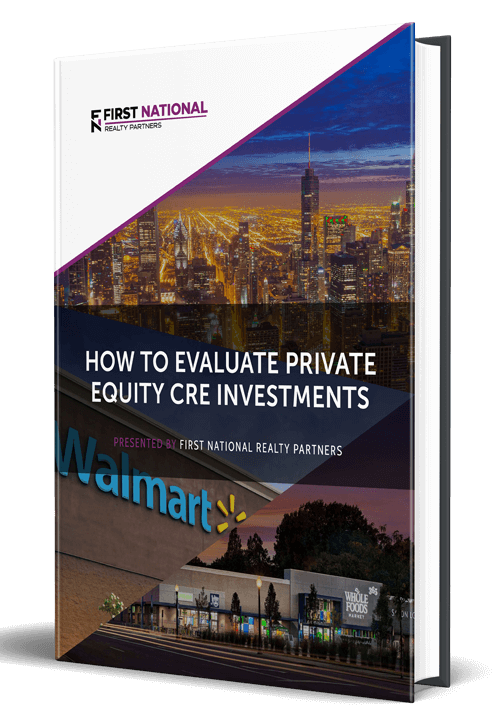In a typical commercial real estate purchase/sale transaction, the “capital stack” consists of two components: debt and equity. The exact amount of each is driven by a number of factors including lender approval criteria, investor return objectives, and available capital.
In this article, we are going to discuss the relationship between debt and equity in the capital stack, as evidenced by the debt to equity ratio. We will describe what the debt to equity ratio is, how it is calculated, and why it matters in the due diligence process. By the end, readers will have a greater understanding of this important metric and will be able to incorporate it into their pre-investment due diligence process.
At First National Realty Partners, we specialize in the acquisition and management of grocery store anchored retail centers. If you are an accredited investor and would like to learn more about our current opportunities, click here.
Understanding the Debt to Equity Ratio: Background Concepts
In order to understand how the debt to equity ratio works, it is first necessary to review four fundamental concepts.
1. Applicable Across Industries
First, the debt to equity ratio metric is not specific to real estate or investment property. It is widely applicable across all industries and is most commonly used as a measure of a company’s financial health.
2. Debt vs. Equity
Second, debt consists of all money owed to a lender. In a clean deal, this may be relatively straightforward with just one senior loan. But, as deals get larger and more complex, this is rarely the case. There may be multiple sources of debt – senior debt and mezzanine debt – as well as other things like shareholder loans.
Equity is the difference between the value of the property and the total liabilities. At the time of purchase, this is equivalent to the down payment, but it may change over time as the property value rises and falls in response to market conditions.
3. Where to Find
Third, these key numbers are typically found on the balance sheet. But, at the time of purchase, there may not be a balance sheet to look at. As such, it may be necessary to use a proxy. Again, this would be the amount of long term debt that will be obtained and the down payment for the property. Sometimes, this is measured as the loan to value ratio, or LTV for short.
4. No Perfect Debt and Equity Mix
Finally, there is no perfect mix of debt and equity, and it is different for every transaction. As a general rule, investors are incentivized to use as much debt as possible because this usually drives higher returns. However, this also raises the risk profile of the transaction. But, if investors use too little debt, they may be leaving some amount of returns on the table.
With these background concepts in mind, let’s begin by defining the debt to equity ratio.
What is the Debt to Equity Ratio?
The debt to equity ratio in a commercial real estate transaction is the amount of debt that is used in the transaction divided by the amount of equity.
Calculating the Debt to Equity Ratio
The formula used to calculate the debt to equity ratio is:
- Total Debt / Total Equity.
Again, the key word in the formula is “total.” On the debt side, it is necessary to include all forms of debt. In a clean transaction, there may just be a single loan, but a more complicated transaction may have senior debt, mezzanine debt, shareholder loans, and other liabilities. Likewise total equity includes all sources of equity – most notably investor contributions.
So, in a very simple example, suppose that a property was purchased for $1,500,000 and there was $1,000,000 in debt and $500,000 in equity – the resulting debt to equity ratio would be 2:1 ($1,000,000 / $500,000).
What is a Good Debt to Equity Ratio?
As a general rule, it is important to remember that investors are incentivized to use more debt in a real estate transaction because it: (1) can boost total returns; and (2) can limit the amount of their own money that investors must commit to the deal. But, it is a fine line because too much debt can leave too little margin for error when market conditions change.
Every transaction and property type is unique, but a good debt to equity ratio is around 70% debt and around 30% equity, or around 2.33:1. So, for a property with a $1,000,000 purchase price, this would be $700,000 in debt and $300,000 in equity.
But, it is important to note that this can vary based on property type. Riskier types like land or restaurants may want less debt and more equity so it could be closer to around 1.5:1 while less risky property types like grocery store anchored retail centers or single tenant net leased properties may be able to get away with around 4:1.
Spectrum of Debt to Equity Ratio: High Risk to Low Risk
At its core, the debt to equity ratio is a metric that is representative of the risk associated with a property – and it exists on a spectrum. At the high risk end of the spectrum, rental property types like land, development projects, restaurants, hotels, or office represent more risk to real estate investors because they can have more variability in cash flow and the debt for them may come with higher interest rates.
At the other end of the risk spectrum, property types like credit tenant net leased properties, grocery anchored retail, or high end multifamily have less risk, more stability, and more favorable lending terms for borrowers.
So, higher risk properties should generally carry less debt and more equity while lower risk properties can get away with higher levels of debt and less equity. As a general rule, no property should exceed a debt to equity ratio of around 5.5:1, otherwise, these levels of higher debt/financial leverage could impact the property’s ability to make its required mortgage payments.
What Does a High Debt to Equity Ratio Mean?
Simply, a high debt to equity ratio means more risk. To illustrate this point, consider an example where a property has a purchase price of $1,000,000.
In the first scenario, the property is purchased with $750,000 debt and $250,000 equity, or a debt to equity ratio of 3:1. In the second scenario, the property is purchased with $850,000 in debt and $150,000 in equity or a debt to equity ratio of 5.66:1.
Now, suppose that the property is moving along just fine, but an economic downturn hits and it loses a key tenant and the vacancy rate jumps from 3% to 10%. Because the property with more debt financing has a higher loan payment, this rise in equity could mean that the rental income is no longer enough to make the loan payment, which can be the start of a series of bad things for the asset.
In the property with less debt, this rise in vacancy may impact the short term returns and the overall return on equity, but it will likely not threaten the property’s viability.
Is It Better to Have a Low Debt to Equity Ratio?
From a risk perspective, yes, it is better to have a low debt to equity ratio. However, it is important to note that lower debt to equity typically means lower returns as well. So, investors must find the sweet spot for the debt to equity ratio that both minimizes risk and maximizes returns.
The Importance of the Debt to Equity Ratio for Investors
When performing due diligence on a potential property investment, calculating the debt to equity ratio is important because it represents risk in the deal. Thus, it can help guide the investor’s decision making process to ensure the risk profile of the investment is a good fit for their own risk tolerance.
Debt to Equity Ratio & Private Equity Real Estate Investing
A private equity firm is a company that invests in the privately held equity of other companies, including those that own real estate. As a result, they give individual investors the opportunity to own a fractional share of an institutional grade commercial real estate asset. In such an arrangement, the private equity firm does all of the hard, upfront work of finding, financing, and managing the asset while investors can sit back and collect their dividends.
In a typical, private equity transaction, the debt to equity ratio is calculated by the firm and they actively work to manage it to acceptable levels for their clients. So, those investors that want to leave all of the hard work of managing the asset up to someone else may find a private equity offering to be compelling.
Summary of the Debt to Equity Ratio
The debt to equity ratio is a metric that measures the amount of debt used to finance a real estate asset relative to the amount of equity.
The debt to equity ratio is calculated as the total amount of debt divided by the total amount of equity. For example, if a property is purchased with $1,000,000 in debt and $500,000 in equity, the debt to equity ratio is 2:1.
Generally, a good ratio is 70% debt and 30% equity or 2.33:1, but this may vary depending on the type of property involved. Higher risk properties like hotels or restaurants may want a lower ratio while lower risk properties like grocery store anchored retail centers may be able to get away with a higher ratio.
A high debt to equity ratio means that the risk profile of the transaction is higher. A low debt to equity ratio means that the risk profile is lower. However, higher amounts of debt can also boost returns so investors must find the sweet spot between risk and return when sizing debt for their property.
For individual investors who want to leave the hard work of calculating debt to equity ratios and managing an asset up to someone else, partnering with a private equity firm to get fractional ownership of a commercial property can be a compelling option.
Interested In Learning More?
First National Realty Partners is one of the country’s leading private equity commercial real estate investment firms. We leverage our decades of expertise and available liquidity to find world-class, multi-tenanted assets below intrinsic value. In doing so, we seek to create superior long-term, risk-adjusted returns for our investors while creating strong economic assets for the communities we invest in.
If you are an Accredited Investor and want to learn more about our investment opportunities, contact us at (800) 605-4966 or info@fnrpusa.com for more information.






